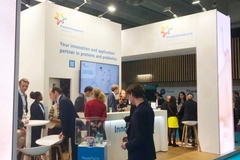Cutting Edge Science at Agricultural Research Forum

The two-day Agricultural Research Forum concludes; The event, being held in Tullamore, County Offaly, will see a total of 151 research papers from research institutions all over the island of Ireland being presented. The programme includes sessions on Environment Greenhouse Gases and Economics; Animal Nutrition, Systems and Engineering; Soils and Nutrients; Animal Nutrition/Meat Science and Molecular; Economics and Farm Systems Modelling; Health and Welfare; Grassland and Biodiversity; Genetic Improvement of Farm Animals; Grassland, Tillage Crops and Biofuels; and Animal Reproduction.

16/03/09 The Forum featured three plenary sessions on ‘The role of systems biology in animal breeding’; ‘The application of soil microbial ecology to understanding environmental issues in Irish agriculture’; and ‘Greenhouses gas reduction targets: An economic assessment of the challenges for Irish agriculture’.
For many decades quantitative geneticists have attempted to identify, as accurately and as early in life as possible, the genetic merit of potential breeding animals using sophisticated statistical methodology. Although resultant genetic gains have been immense, the approaches used were not without their shortcomings. Molecular technologies exploiting knowledge on the genome of individuals as well as how the different genes are expressed and translated into protein offer great potential to further increase genetic gain. However, these technologies have, to date, not been fully exploited in animal breeding due to a number of factors such as previous limitations of the technologies, but probably more so the lack of strong collaboration between researchers across the different disciplines.
“Ireland is developing strong capabilities in the emerging technologies and recent collaboration between quantitative and molecular geneticists at Teagasc and the Irish Cattle Breeding Federation has resulted in Ireland being the second country in the world to release official estimates of the genetic merit of dairy sires based on their respective genome; this approach is termed genomic selection,” explained Donagh Berry, Moorepark Dairy Production Research Centre, in a plenary paper.
“Adoption of this technology is a quantum leap for animal breeding, and Ireland is to the forefront of these developments, achievable only through strong collaboration between the different disciplines. Genomic selection will increase genetic gain in Ireland by 50 percent which is worth €8 million annually to the Irish dairy industry; this is cumulative and permanent. The potential gains for Ireland’s beef industry are substantially greater. However, genomic selection has its own limitations and stronger collaboration among Irish and international researchers, across the different disciplines of animal production, quantitative genetics, genomics, transcriptomics, metabolomics, proteomics and bioinformatics, as well as the social sciences, is vital to ensure the momentum gained through recent collaboration is sustained. Ireland is in one of the strongest positions internationally to fully exploit these new technologies for the benefit of the Irish Agri-Food industry.”
Teagasc has warned that if significant reductions in greenhouse gas (GHG) emissions are demanded from agriculture that it may only be possible if the Irish cattle population were to go into steep decline over the next ten years.
Trevor Donnellan and colleagues in the Rural Economy Research Centre, addressed the issue of agricultural GHG emissions from an economic standpoint in their plenary paper. “Agriculture is one sector of the economy in which GHG emissions are actually already decreasing. New research by Teagasc economists indicates that emissions from agriculture will continue to fall over the next decade and that a reduction of 10 percent relative to 2005 levels is possible.”
Continuing he said: “Greenhouse gas emissions from all sectors of the economy are a growing concern. The Government has signed up to an EU commitment to reduce Ireland’s total GHG emissions by at least 20 percent and by as much as 30 percent by 2020. Due to increases in population and higher levels of economic activity, total Irish GHG emissions have been growing over time and are projected to continue to increase unless measures are taken to reduce emissions.”
In most developed economies agriculture is a small component of overall GHG emissions. Countries such as Ireland and New Zealand are notable exceptions. Agriculture in both countries is highly export focused and hence is much larger than it would be if it were just supplying food for the domestic market. As a result, agricultural GHG emissions in Ireland are currently over one quarter of the country’s total emissions.
“In Ireland, scientific research is exploring changes to farming methods that will reduce GHG emissions from agriculture. But it will take time for science to produce results than can be adopted by farmers and then become standard agricultural practice. Given the scale of the national GHG reduction target, adjustment in the agricultural sector will continue to be demanded by other sectors of the economy,” concluded the Teagasc researcher.













